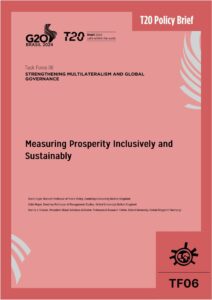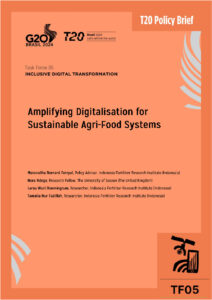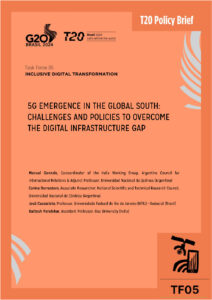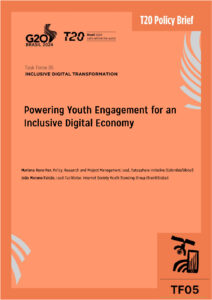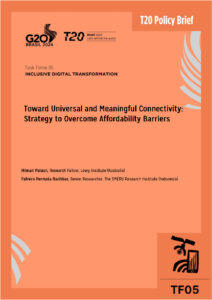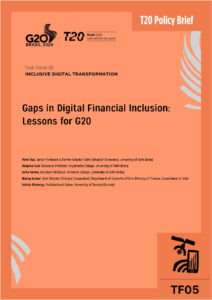World Trade Organization (WTO) members have divergent views about developing country-member status and special and differential treatment (SDT), reflecting different perceptions about what constitutes fair treatment in the WTO. Such differences have recently become more accentuated, posing a challenge for the organization.
Debates about SDT have covered a complex set of issues including the definition of a developing country member, graduation, the effectiveness of SDT, and technical assistance and capacity building. This policy brief argues that, instead of looking for objective generic criteria to classify developing and developed members, WTO members should focus on solving the matter in a more flexible and needs-oriented manner. This could be by addressing issues on a case-by-case basis, in view of the particular SDT architecture under consideration for the negotiation at hand.
Developing country members should be willing to assume obligations commensurate with their level of development and economic capacity. Developed members should be committed to a pragmatic, results-oriented approach.
Challenge
DEVELOPMENT AND SDT IN WTO REFORM DISCUSSIONS
There is broad convergence about the need to reform the World Trade Organization (WTO). The G20 has expressed support for the necessary reform of the WTO on various occasions, including at the latest G20 Leaders’ Declaration of November 2020 and Trade and Investment Ministerial Communiqué of September 2020.
Reforming the WTO, however, is challenging for various reasons. Among these is the absence of a shared view about how to deal with the special and differential treatment (SDT) enjoyed by developing country members.
SELF-DESIGNATION OF DEVELOPMENT STATUS AND SPECIAL AND DIFFERENTIAL TREATMENT (SDT)
There is no WTO definition for developing and developed members but rather a long-established practice of WTO members self-designating their development status.
Developing-country status entitles members to SDT, or more flexible and favourable conditions in WTO agreements, such as longer timeframes to implement legal commitments.1
SDT provisions are a common feature of WTO agreements, including the General Agreement on Tariffs and Trade (GATT) and the goods-related agreements,2 the Agreement on Trade-Related Aspects of Intellectual Property Rights (TRIPS) and the General Agreement on Trade in Services (GATS).3
Having noted the above, the proposal contained in this policy brief focuses on future agreements only. It argues that existing SDT provisions should not be changed except as a result of specific negotiations.
OPPOSING VIEWS ON THE ISSUE
Discussions about which WTO members should benefit from developing country member status in future legal commitments have gained prominence particularly since 2019 in the past few years.
Certain members challenge self-designation, arguing, in particular, that it is not appropriate for emerging economies to claim developing-member status and benefit from flexibilities that should be limited to members in earlier stages of development.4
The United States has been especially vocal in asserting that self-declaration damages the negotiating function of the WTO because developed countries are then reluctant to make concessions to smaller economies if large emerging ones also benefit from such flexibilities.
Other members, such as the the European Union (EU), Canada and Japan, have also called for changes to the existing approach. The EU, for example, argues that “it is not sustainable that two thirds of the membership including some of the world’s most significant economies claim special and differential treatment” (European Commission, 2021).
In November 2019, the United States proposed what it saw as criteria for determining which members could not avail themselves of SDT in current or future WTO negotiations (United States 2019a). According to the proposal, a member would not be granted SDT flexibilities if, for instance, it is a G20 member, an OECD member or acceding member, or if it accounts for more than 0.5% of global merchandise trade.
Most developing country members, however, oppose forgoing the right to self-designate their development status. Consequently, they are against fixed criteria defining whether they should be treated as a developing or a developed member and therefore entitled to SDT. Moreover, they argue that discussions should instead focus on strengthening SDT provisions and making them more effective. They also argue that SDT is a treaty embedded right (China et al., 2019). In recent years, however, some WTO members, including Brazil, Korea and Chinese Taipei, have announced that they would not seek SDT flexibilities in future WTO agreements.
Several WTO members have also submitted specific suggestions related to the issue, including Bolivia, Canada, Central African Republic, China, Cuba, the EU, Hong Kong, China, Iceland, India, Lao PDR, Mexico, Norway, New Zealand, Pakistan, Kenya, Singapore, South Africa, Switzerland, Venezuela, in addition to the African Group.
A shared understanding on the matter has thus far eluded WTO members. Instead, heated debates about developing-member status and SDT have contributed to eroding trust and goodwill among members in Geneva.
Development status disagreements pose a challenge to current and future trade negotiations and affect the prospects for WTO reform.
Proposal
The issues of developing-member status and SDT have been subject to various proposals over the past few years, not only from WTO members themselves but also from trade experts.
In line with the US proposal, many suggest that objective parameters and criteria should be adopted to clearly define which members should benefit from SDT in future WTO agreements.
This policy brief argues that such an approach is unlikely to succeed. Delegations in Geneva risk embarking on a divisive debate about reclassification of members. More than a distraction, there will be never-ending discussions around the most appropriate metrics to measure development that will further undermine trust among members without bearing fruit.
However, dismissing the concerns of those who defend a different approach to SDT is not the best way forward. Left unaddressed, such concerns are an obstacle to advancing negotiations in the WTO, impacting on its relevance and compromising its credibility. This is why the issue of developing-country status matters for the entire WTO membership.
This policy brief therefore defends a pragmatic, issue-by-issue approach to address development status and SDT in the WTO, based on past experience and new, creative solutions.
Instead of negotiating fixed criteria, this policy brief argues that, in current and future negotiations, WTO members should concretely consider the issue under discussion and design the SDT architecture most suitable to the case in hand.
Flexibility and need are the key features of this new approach. It means, for instance, that a member could benefit from SDT in an agreement on a given issue, such as fisheries subsidies, if needed. However, that same member might not benefit from SDT in another area, such as agriculture, if it is not warranted.
In the proposed approach, real needs are therefore more important than development status. Arguably, even developed countries could benefit from this kind of flexibility if tightly circumscribed for example, if reducing tariffs on a given environmental good is too difficult or sensitive, it could ask for an additional time period to reduce its tariffs.
In fact, the existence of tariff peaks in the legal commitments of developed members is a sign that such an approach would not be a complete novelty. All WTO members have sensitivities regarding undertaking trade commitments. By acknowledging that reality and providing for negotiating mechanisms to address it, this approach could create incentives for constructive engagement across members, regardless of their development levels.
This policy brief argues that different types of agreements require different types of SDT architectures.
Market access SDT. For this type of SDT, applicable to tariffs on goods or market access in services sectors, members should discuss in concrete terms how individual members could design their implementation schedules. For example, in terms of tariffs, members could negotiate the pace of tariff reductions as well as a limited number of exceptions or exclusions.
In the Expansion of the Information Technology Agreement of 2015, participants in that plurilateral endeavour agreed to individual, participant-specific timeframes for tariff elimination for products covered by the agreement. As a result of the negotiation process, China, for example, committed to an implementation scheme that was more ambitious than those of other developing economies. That outcome was possible without the adoption of fixed criteria to define which participants should contribute more (i.e. reduce tariffs faster). Moreover, the development status of participants proved not to be an obstacle for the successful conclusion of this negotiation.
Other creative ideas could also be conceived in the same spirit, customizing negotiated commitments at a very granular level if needed. By taking a case-by-case approach, SDT could be provided where it is needed most, either through a sectoral or even tariff line approach. For example, in a given tariff negotiation, a phase-in scheme could be agreed to at the tariff-line level, or even a more specific level. Benchmarks could be established such as a countries’ level of trade competitiveness in a particular sector. This could be, for instance, a country’s share of world trade above which it is no longer eligible for SDT, say, 2% of world exports in that given product or a similar reference members find relevant. This stands to reason as being above such a threshold would suggest that a country is competitive in that sector/product and therefore not in need of SDT.
There are various ways to design thresholds and phase-in mechanisms, providing members with the flexibility they may need to find compromise. Importantly, members could design these mechanisms in a way that prioritizes real implementation capacity, or a member’s participation in trade, if that is relevant criteria.5 These kinds of provisions would also help address the long-standing criticism from developing country members that SDT normally only provides for additional implementation periods and disregards, for example, effective capacity to implement a commitment. In this spirit, even support for trade-related adjustment policies could be considered, so as to mitigate potential short-term negative effects of market liberalization.
Regulatory SDT refers to provisions for special and differential treatment in agreements that include rule-related disciplines, such as e-commerce, investment facilitation and trade facilitation.
The Trade Facilitation Agreement, agreed in 2013, is the best example of this and in fact represents a new, pathbreaking DNA in how to address issues related to development at the WTO.6 Each developing country member was allowed to establish the implementation period required for each provision of the agreement and was entitled to define whether technical assistance and capacity building were required. Self-designation, or each member’s decisions about its own implementation periods and support needs, was considered a key element of the TFA model, which allowed for tailor-made flexibilities decided individually by each developing member.7
Some large developing country members showed commitment to a speedy implementation of the TFA: “Nine developing countries have notified their readiness to immediately observe all obligations, and 30 others, including Brazil and China, have agreed to immediately implement more than 75% of commitments” (González, 2019). The schedules presented by China and Brazil, for example, contained only a limited number of provisions requiring additional implementation periods. None of these members requested technical assistance or capacity building, even though it was available to all developing country members. With that, China’s and Brazil’s commitments were similar to those undertaken by developed members, for which all obligations became mandatory once the agreement entered into force.
The TFA offers important lessons about the design of innovative and flexible SDT. Additionally, it shows that it is possible in practice for large developing economies to undertake commitments commensurate with their level of development.
The SDT architecture of the TFA can certainly inspire other regulatory agreements. For market access, however, given the very nature of the commitments, it looks more challenging to link something such as technical assistance to tariff reduction implementation, for example. Even so, this could be explored. For example, a market access commitment to open a given service sector could be contingent on the member in question adopting or implementing an appropriate legal framework (e.g. in financial services or telecoms), establishing a necessary regulatory agency, or digitizing certain government procedures. For this, technical assistance could be helpful.
Procedural tools can also prove useful. The Agreements on Technical Barriers to Trade (TBT) and on Sanitary and Phytosanitary Measures (SPS) allow members to raise specific trade concerns, counting on a structured pathway for consultations and problem-solving among members. That could constitute an additional means to address development needs without even involving SDT (González, 2019). A mechanism inspired by existing specific trade concerns but focused on development and implementation issues could be embodied in current and future negotiations.
In regulatory agreements (i.e. not market-access ones), the issue of support to effective implementation merits attention. In some cases, there could be support for the adoption of new legislation to streamline government procedures or to facilitate investment, for instance. But more than in the formal adoption of any piece of legislation, problems often reside in effectively complying with / implementing such regulations. The provision of technical assistance should be mindful of this.
Here, once again, the TFA provides useful guidance. Using needs-assessment methodologies, members define the appropriate technical assistance solution to the problem identified. Such assistance could be to put in place a necessary legal framework or, as needed, to help implement it in case an appropriate one exists. Real needs should determine the best type of technical assistance.
In short, members should use all the tools available to help pragmatically address the issue, sidestepping politically charged discussions. Experience has shown that it is possible. Creativity and political will can further help.
SDT AND PLURILATERAL AGREEMENTS
Plurilateral negotiations, involving less than the full membership, have gained prominence in the WTO particularly since 2015 over the past few years given blockages because of the need for the agreement of all members in multilateral negotiations. How do plurilateral negotiations affect the issue of developing-member status and SDT?
In a plurilateral setting, because participants actively want to be involved in the negotiation, it is more difficult to use SDT or any other issue to block discussions. Given the nature of plurilateral talks, members can only withdraw from a negotiating process or opt not to join a given plurilateral outcome if they do not wish to support it.
In that sense, discussions about development and SDT become less critical in the context of plurilateral negotiations because, to a large extent,8 the possibility of SDT being used as a threat to block discussions is less straightforward. The logic of exercising veto power does not apply as it does in a multilateral process. With that, SDT becomes less amenable to hostage-taking in plurilateral agreements.
However, there is nothing that would prevent the SDT approach suggested in this policy brief being incorporated in plurilateral negotiations as a possible way to deal with sensitive issues. Plurilaterals should contain incentives for members, including developing ones, to participate. Hence, innovative, flexible, tailor-made SDT provisions should be a feature of such future agreements.
This is particularly important if participants believe that such agreements should include a large part of the membership and if the objective is to help integrate developing countries in the trading system. Indeed, if designed correctly, plurilateral agreements can be an important building block to multilateral outcomes and thus a vital part of the WTO reform effort.
WHAT WOULD IT TAKE FOR THE PROPOSED APPROACH TO WORK?
For this approach to work in practice, certain elements need to be present:
– Key members, including large, developed and developing countries, would have to be committed to reinvigorating the WTO negotiating function. They would have to be genuinely interested in reaching negotiated outcomes.
– All WTO members would need to be ready to assume responsibilities commensurate with their level of development. Larger developing countries would need to be willing to act on the understanding that their development needs are not the same as those of smaller economies. In short, political will on both sides would be needed.
– It would also take the leadership of key G20 developing and developed country members to champion such an approach, sidestepping the unfruitful path of reclassifying developing country members.
– The proposed approach should apply to future obligations only. Existing SDT provisions should not be changed except as a result of specific negotiations.
– The current understanding about SDT provisions for least-developed countries (LDCs) should remain unchanged. Special treatment for LDCs is uncontroversial and therefore should not be affected by the proposed approach. Graduating LDCs could also continue to be eligible for these flexibilities, on a case-by-case basis.
– Developing-member status and self-designation would potentially be less problematic issues, as they would bear less of a consequence for the SDT approach proposed here.
– Technical assistance and capacity building must be taken seriously. It should not be seen as a gift to developing country members but rather as something of interest both to those who provide it and those who receive it. The integration of developing country members into the trading system is in the interest of all members.
– Finally, flexibility and special treatment should be available to all members, including developed ones if there is a legitimate, targeted need. Negotiations would determine the outcomes on a case-by-case basis.
CAN SUCH A FLEXIBLE APPROACH, WITH NO HARD PARAMETERS, EVER WORK?
The absence of predefined criteria to address the issue of SDT is a strength rather than a weakness of the proposed approach. As noted, the negotiation of parameters in abstract is unlikely to succeed. Additionally and more importantly, members have successfully dealt with other fluid concepts in WTO negotiations in the past, such as critical mass in plurilateral agreements. The lack of a clear definition of critical mass has not prevented members from concluding agreements based on that concept, such as the Expansion of the Information Technology Agreement.
HOW CAN THE G20 HELP ADVANCE THE PROPOSED APPROACH?
G20 Leaders could task their Trade Ministers and invite other WTO members to develop the ideas proposed by this policy brief and to capture such understanding in a statement or paragraph of the G20 Leaders Declaration. That would provide much-needed guidance and political support to negotiators in Geneva.
In terms of substance, G20 members could consider the following elements in drafting language to advance the proposed approach:
– Recommit to the WTO and its negotiating function; –Express the commitment to undertake henceforward a more pragmatic, flexible and tailor-made approach to SDT; and call for such an approach in the WTO;
– Express the shared view that the ultimate goal of SDT is to facilitate the integration of all members to the trading system in a manner consistent with their needs and capacities;
– Acknowledge that all G20 countries are ready to assume, in the WTO, responsibilities commensurate with their level of development;
– Acknowledge that self-designation of development status and SDT would not preclude such an approach;
– Recall that members have devised innovative SDT architecture to address the needs of developing country members in the past and that the TFA and other negotiations can provide important lessons;
– Reiterate the commitment to continue to provide effective and meaningful SDT for LDCs, and on a case-by-case basis, even to graduated LDCs;
– Underscore that existing SDT obligations remain unchanged; and –Encourage all WTO members participating in plurilateral and multilateral initiatives to take a new approach to SDT in ongoing and future negotiations.
APPENDIX
Types of SDT in WTO agreements

Source: Based on WTO Secretariat (2018 [2019]).
NOTES
1 The WTO Secretariat has updated a mapping exercise of SDT provisions in WTO Agreements and has identified 155 of them (excluded from this count are several Ministerial Declarations, and decisions from the General Council and other bodies containing S&D provisions). According to a typology developed by the Secretariat, these provisions can be classified into six categories, including, for example, provisions establishing more flexible commitments, technical assistance as well as additional transition periods: WTO Secretariat (2018 [2019]). See Appendix for a summary table.
2 In the area of agriculture, for example, only developing countries can benefit from the Bali Decision on public stockholding for food security purposes of 2013. Certain provisions of the Agreement on Subsidies and Countervailing Measures (ASCM) grant flexibilities limited to”developing countries.
3 According to the positive-list approach of the GATS, WTO members identify the sectors where they undertake commitments. With that, the GATS architecture is seen as flexible in itself and makes discussions about development status less relevant in the context of this agreement.
4 The United States argues that it “makes no sense today in light of the vast changes in development and increasing heterogeneity among Members” (United States, 2019b).
5 See, for example, proposal from Norway and others: “In various WTO agreements, phase-in periods are an important element of S&D. In other cases, thresholds must be triggered before commitments kick in. Time-bound and threshold provisions are useful flexibility mechanisms that clearly imply a commitment towards increased engagement in the multilateral trading system” (Norway et al., 2019).
6 For the first in the history of the multilateral trading system, the obligation to implement a given provision was linked to the ability of the developing or least developed member to do so. At the same time, the Agreement recognized the need for donor members to provide support for developing and least-developed members to build such capacity.
7 The WTO set up the Trade Facilitation Agreement Facility in July 2014 to support developing country members in need of assistance to implement the Agreement. The TFA approach to SDT has been welcomed by many as a more effective approach towards including developing country members in the trading system.
8 That is because if a big members decides not to engage in a plurilateral process, that may prevent the existence of critical mass, risking the entire endeavour. While no single member has veto power in plurilateral negotiations, in reality some have a significant impact for their sheer size.
REFERENCES
African Group, Cuba, India (2020). Strengthening the WTO to promote development and inclusivity (WT/GC/W/778/Rev.3), 4 December
Bertelsmann Stiftung (2020). What do we need a World Trade Organization for? The crisis of the rule-based trading system and WTO reform. https://www.bertelsmann-stiftung.de/fileadmin/files/user_upload/MT_WTO_Reform_2020_ENG.pdf accessed 23 July 2020
Bernard Hoekman B, Tu X and Wang D (2021). Rebooting Multilateral Trade Cooperation: Perspectives from China and Europe. London: CEPR Press
Canada (2018). Strengthening and modernizing the WTO. Discussion Paper (JOB/ GC/201), 24 September
China (2019). China’s proposal on WTO reform (WT/GC/W/773), 13 May. https://images.mofcom.gov.cn/sms/201905/20190514094326217.pdf, accessed 23 July 2019
China, India, South Africa, The Bolivarian Republic of Venezuela, Lao People’s Democratic Republic, Plurinational State of Bolivia, Kenya, Cuba, Central African Republic and Pakistan (2019). The continued relevance of special and differential treatment in favor of developing members to promote development and ensure inclusiveness (WT/GC/W/765/Rev.2), 4 March
European Commission (2018). Concept paper on WTO modernization. 18 September. https://trade.ec.europa.eu/doclib/docs/2018/september/tradoc_157331.pdf accessed 23 July 2021
European Commission (2021). Trade policy review – an open, sustainable and assertive trade policy. 18 February. https://trade.ec.europa.eu/doclib/docs/2021/february/tradoc_159438.pdf accessed 23 July 2021
González A (2019). Bridging the divide between developed and developing countries in WTO negotiations. Peterson Institute for International Economics. https://www.piie.com/blogs/trade-and-investment-policy-watch/bridging-divide-between-developed-and-developing-countries accessed 23 July 2021
Hoekman B, Mavroidis P (2020). Preventing the bad from getting worse: The end of the World Trade Organization as we know it? EUI Working Papers. https://scholarship.law.columbia.edu/cgi/viewcontent.cgi?article=3610&context=faculty_scholarship accessed 23 July 2021
Bacchus J and Manak I (2021). The Development Dimension: Special and Differential Treatment in Trade. London and New York: Routledge
Keck A, Low P (2005). Special and differential treatment in the WTO: Why, when and how? WTO Staff Working Papers. https://econpapers.repec.org/paper/zbwwtowps/ersd200403.htm accessed 23 July 2021
Norway, Canada, Hong Kong (China), Iceland, Mexico, New Zealand, Singapore and Switzerland (2019). Pursuing the development dimension in WTO rule-making efforts (WT/GC/W/770/Rev.3), 8 May
United States (2019a). Draft general council decision. Procedures to strengthen the negotiating function of the WTO (WT/ GC/W/764/Rev.1), 25 November 2019
United States (2019b). An undifferentiated WTO: Self-declared development status risks institutional irrelevance (WT/ GC/W/757/Rev.1), 14 February 2019
WTO Secretariat (2018 [2019]). Special and differential treatment provisions in WTO agreements in decisions. Note by the Secretariat (WT/COMTD/W/239), 12 Octo ber 2018 and Corrigendum (WT/COMTD/W/239/Corr.1), 20 December 2019



